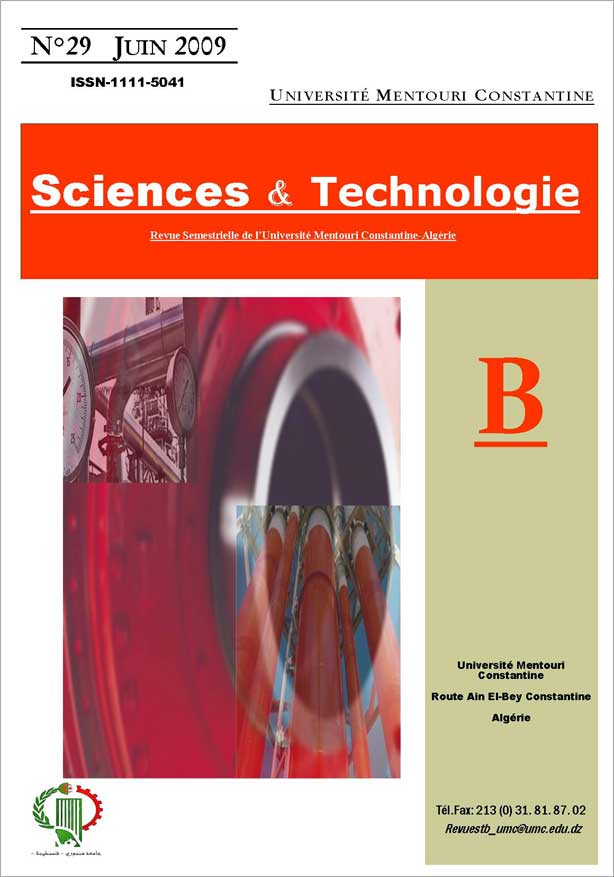PREDICTION OF FATIGUE LIFE OF AUTOMOTIVE ALUMINUM LOWER SUSPENSION ARM
Mots-clés :
Fatigue, aluminium, automotive, suspension, optimisation, failureRésumé
The objective of this study is to evaluate the potential of light alloy use in automobile parts by studying their fatigue life using various parameters such as the effect of the suspension, the nature of the excitation, the
geometry and the weight of the part. The part under study is the lower suspension arm made of 7075-T6 aluminium alloy. The energy approach enables us to compare two of the same order of tensors, the multiaxial and
the uniaxial cases. In both cases, the strain energy density is a zero tensor order. The random displacement excitation is obtained analytically from the power spectral density PSD. The force excitation is obtained by a simple normalisation of spectrum displacement. To avoid the use of the Newton-Raphson method, during the partial fatigue life calculation step in all the elements of the mesh, we create a Matlab interface to identify the critical elements. The strain energy SENER signal of the critical element is corrected to remove the anomalies by a WAFO Matlab interface algorithm. Rainflow cycles are extracted using the Markov formulation in order to calculate the number of signal repetitions to failure, wich is calculated from the Miner law. The results show that the studied loading signal must be repeated 8.86*1011 times before a 25 mm thick aluminium 7075-T6 alloy part
ruptures.
Références
A Bignonnet "Approche globale d’allégement des véhicules "
Mec. Ind. (2001) 2, pp 173-180.
W. S. Miller, L. Zhuang, J. Bottema, A. J. Wittebrood, P. De
Smet, A. Haszler and A. Vieregge "Recent development in aluminium alloys for the automotive industry" Materials Science and Engineering, A280 (2000), pp 37-49.
Masaaki Saito, Shuuichiro Iwatsuki, Kunihiro Yasunaga and
Kimitaka Andoh "Development of aluminium body for the most fuel efficient vehicle" JSAE Review 21 (2000) pp 511-516.
K. Wilfred, P. M. Jean and Z. Gérald "Introduction à la science
des matériaux" Presse Polytechniques et Universitaires Romandes, second edition, 404 pages, 1991.
André Bazergui, Thang Bui-Quo, André Biron, Georges McIntyre and Charles Laberge,"Résistance des matériaux"
second edition, École Polytechnique de Montréal, 1993, 595
pages.
S. Cervello, G. Donzella and A. Pola "Analysis and design of a
low-noise railway wheel" Proceedings of the Institution of
mechanical Engineers. Part F, Journal of Rail, Vol 215, 2001, pp 79-92.
A. Elmarakbi, H. El-hage and S. Bhattacharjee "Multiaxial
fatigue crack initiation by strain energy density using finite
element method" CSME Forum 2002, Kingston, may 21-24.
W. V. Mars "Cracking energy density as a predictor of fatigue
life under multiaxial conditions" Rubber Chemistry and Technology, Akron, Mar/Apr 2002, pp 1-17.
A. de-Andrés, J.L.Pérez and M. Ortiz, "Elastoplastic finite
element analysis of three-dimensional fatigue crack growth in
aluminium shafts subjected to axial loading" International
Journal of Solids and Structures, 36 (1999), pp 2231-2258.
H. Rahnejat "Multi-Body-Dynamics : vehicles, machines and
mechanisms" Society of Automotive Engineers, Inc., 1998, 355 pages.
M. Bouazara "Étude et analyse de la suspension active et
semi-active des véhicules routiers" Ph.D. thesis, Laval university, 197p. 1997.
M. Gbadebo Owolabi, Meera and N. K. Sing "A comparison
between analytical models that approximate notch-root elastic-plastic strain-stress components in two-phase, particule-reinforced, metal matrix composites under multiaxial cyclic loading: Theory" International Journal of Fatigue, 28, (2006) pp 910-917.
M. Gbadebo Owolabi, Meera and N.K. Sing "A comparison
between analytical models that approximate notch-root elastic-plastic strain-stress components in two-phase, particule-reinforced, metal matrix composites under multiaxial cyclic loading: experiments" International Journal of Fatigue, 28, (2006) pp 918-925.
J. S Sun, K. H Lee. and H. P. Lee "Comparison of implicit
and explicit finite element methods for dynamic problems"
Journal of Materials Processing Technology 105 (2000) pp
-118.
N. Rebelo, J. C. Nagategaal and Taylor L. M. "Comparison of
implicit and explicit finite element methods in the simulation
forming processes" Numerical methods in industrial forming
processes: proceedings 4th international 1992 pp 99-108.
M. Haiba, D. C. Barton and P. C. Levesley "The development of an optimization algorithm based on fatigue life" International Journal of Fatigue 25 (2003) 299-310.
Téléchargements
Publié
Numéro
Rubrique
Licence
Les auteurs publiant dans cette revue acceptent les termes suivants :- Les auteurs détiennent le droit d'auteurs et accordent à la revue
le droit de première publication, avec l’ouvrage disponible simultanément [SPÉCIFIER LA PÉRIODE DE TEMPS] après publication, sous la licence Licence d’attribution Creative Commons qui permet à d'autres de partager l'ouvrage en en reconnaissant la paternité et la publication initiale dans cette revue. - Les auteurs peuvent conclure des ententes contractuelles additionnelles et séparées pour la diffusion non exclusive de la version imprimée de l'ouvrage par la revue (par ex., le dépôt institutionnel ou la publication dans un livre), accompagné d'une mention reconnaissant sa publication initiale dans cette revue.
- Les auteurs ont le droit et sont encouragés à publier leur ouvrage en ligne (par ex., dans un dépôt institutionnel ou sur le site Web d'une institution) avant et pendant le processus de soumission, car cela peut mener à des échanges fructueux ainsi qu'à un nombre plus important, plus rapidement, de références à l’ouvrage publié (Consulter The Effect of Open Access).

